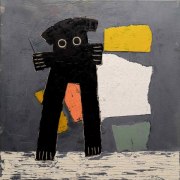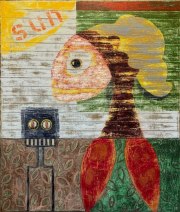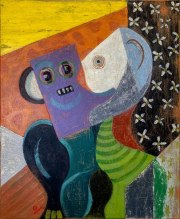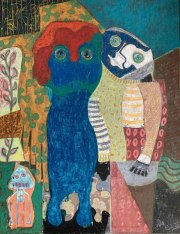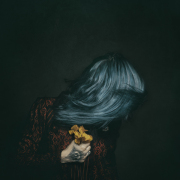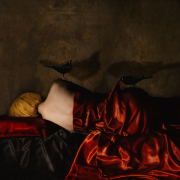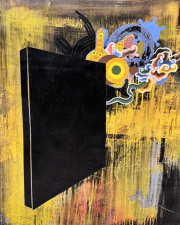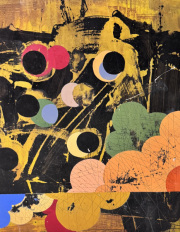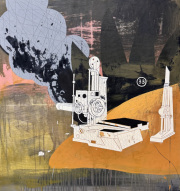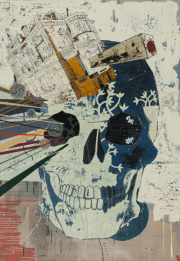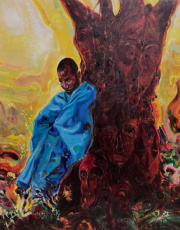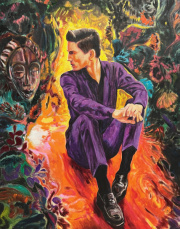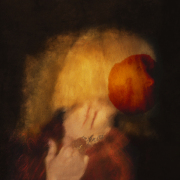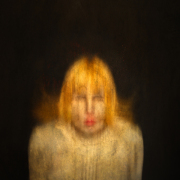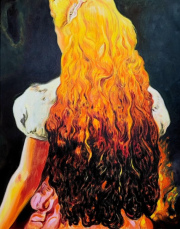Jose Girl, MASCH, Armando Marino, Juan Miguel Pozo
July 4th – August 23rd 2025
opening reception: July 4th, 5-9pm
The group exhibition „Echoes & Constructs“ brings together four artistic positions that in different ways address the relationship between image and reality, memory and the present, construction and fragment. In this show of photography and painting, a visual coordinate system unfolds between dream landscapes, urban utopia, iconographic condensation and the play with perception
In her series „Tenebris Somniorum“, Spanish photographer Jose Girl (born 1977 in Zaragoza, has lived in California since 2010) moves the viewer into the twilight of inner landscapes. Her works, formally indebted to photography, cite painterly traditions – from dark romanticism and baroque lighting to the symbolism of Goya – while at the same time transcend their boundaries. The edges of the picture darken like the consciousness in a dream, while archetypal figures and symbols emerge from the center of the picture.
Jose Girl does not construct an image, but a narrative, a visual cipher of inner movement. Her textures oscillate between sharp representationalism and amorphous abstraction, as if meanings become blurred at the moment of viewing. In this intermediate zone, a unique form of oneiric pictorial composition emerges.
The artist has featured two solo exhibitions at janinebeangallery and apart from that has exhibited mainly in California, Spain and Mexico. In addition to photography, she also works as a director and artistic director for music videos and documentaries.
MASCH, born in 1950 in Rhineland, Germany, lives and works in Berlin. The artist pursues a radically stylized form of painting that is fed by geometric fields, polygonal figures and colourful plateaus. His pictorial world is clear, but not stiff—rather, it is permeated by a quiet irony and a narrative whimsicality. MASCH takes up forms of cubism and mural painting in order to weave them
into his own world of signs. The works are reminiscent of archaic glyphs, infused with urban poetry and everyday humor. They are a paintings of pictorial depth that do not seek to create illusion, but rather challenge patterns of thought and vision—like a logbook from a parallel visual system.
MASCH studied painting at the UdK Berlin and was also active as a musician and set designer. He was awarded an Oscar in 2015 for his work as an art painter on the film „The Grand Budapest Hotel“. This experience as a border crosser between fine art and applied pictorial space is reflected in the confident, undogmatic formal language of his works. Cuban artist Armando Mariño, born in Santiago de Cuba in 1968, now lives and works in the USA, exhibiting his artworks internationally. After training at the Provincial School of Arts in Santiago and the Higher Pedagogical Institute in Havana, he later studied at the Rijksakademie van Beeldende Kunsten in Amsterdam. His artistic development is characterized by a multi-layered cultural environment as well as personal and social conflicts, reflected in his paintings.
Cuban artist Armando Mariño, born in Santiago de Cuba in 1968, now lives and works in the USA, exhibiting his artworks internationally. After training at the Provincial School of Arts in Santiago and the Higher Pedagogical Institute in Havana, he later studied at the Rijksakademie van Beeldende Kunsten in Amsterdam. His artistic development is characterized by a multi-layered cultural environment as well as personal and social conflicts, reflected in his paintings.
Armando Mariño’s works expressively and skillfully to use painting as an arena of cultural and political friction.His technique alternates between impasto brushstrokes, superimposed layers and targeted fragmentation. Mariño explicitly refers to an iconographic archive from art history, the media world and political symbolism—not as a quotation, however, but as a deconstruction. His pictures are visual confrontations, deliberately ambivalent and resistant, as seductive as they are uncomfortable
in their power of color.
Juan Miguel Pozo, born in 1967 in Holguín, Cuba, came to Europe from Havana in 1994 after a German journalist discovered his talent and helped him to emigrate by a scholarship at the Düsseldorf Art Academy. Moving on to Berlin, Pozo found an unexpected closeness to his past facing recurring socialist aesthetics, architecture and a dialog with history.
His works show architectural fragments: Floating buildings, free-standing staircases, urban elements seemingly without any function. They seem like relics of a vanished future, model-like and at the same time marked by decay. Pozo addresses the relationship between ideology, structure and personal memory. His compositions intertwine dystopia and utopia, Eastern modernism and the
Caribbean, Berlin and Havana—in a state of permanent dislocation.
Pozo’s artworks are represented in numerous important collections, including Ella Fontanals- Cisneros, the Pérez Art Museum Miami (PAMM), the Falckenberg Collection and the Ludwig Collection.

